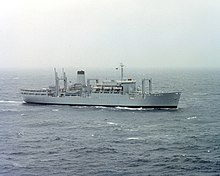Supply ship
Military supply ships are auxiliary ships which serve to supply warships with fuel , provisions , ammunition and other goods at sea, at anchor or in port. Your task is to increase the operating times of the warships at sea and outside their home base. The supply ships also include supply ships that do not support combat units directly in action, but are used for follow-up supply and support. These include material transporters, operating material transporters and workshop ships. They deliver supplies to the fleet suppliers and tenders or carry out major repairs outside the actual conflict zone.
General
Supply ships have been from the Roman navy in ancient times used to supplies and soldiers to carry. A number of different types of supply vessels have developed over time. The main types are:
- Fleet supplier
- tender
- Other auxiliary ships and transporters
Supply ships are usually only lightly armed and are deployed either in an association protecting warships or in a safe sea or coastal area. They can have a military or civilian occupation. Their integration into the navy varies. The British and the US Navy have with the Royal Fleet Auxiliary Service or the Military Sealift Command your own commands with civil occupied auxiliary ships. Subordinate to the latter are a number of supply ships that also serve to support other branches of the armed forces and are known as prepositioning ships . These include the Fast Sealift Ships , which are the world's fastest transport ships, both civil and military.
In the German Navy , the fleet suppliers and other auxiliary ships are subordinate to the supply squadron belonging to the Operational Flotilla 2 . While the task force supplies are manned by the military, the other auxiliary ships are manned by civilians. The tenders belong to the boat squadrons of the operational flotilla 1 .
Derived from the English term Auxiliary (= support), the supply units are classified in the NATO identification system with the letter "A", which forms the beginning of the fuselage number .
Fleet supplier

Fleet suppliers are used to supply operational units of the naval forces and are integrated into them. They have special facilities in order to be able to hand over their supplies while sailing at sea. Usually this is done with the help of a high-line harness to a ship running in parallel (transverse supply). In this way, fuel and water hoses can be transferred. It is also possible to transfer pallets with general cargo from ship to ship on a tension hawser. People can also be transported with light, hand-operated crockery.
Another possibility is to drag a hose to which the ships to be supplied can approach. You fish the end of the hose out of the water and take it to the deck (bow-stern supply). However, this method is slower than the cross supply and does not allow the transfer of piece goods.
Alternatively, helicopters are often used for general cargo and passenger transport. The pallets are usually transported as an external load , which the helicopter hooks in floating above the deck and also sets down on the deck of the ship being supplied without landing (vertical supply). The supply ships usually have their own transport helicopters for this task.
The fleet suppliers of the German Navy include the task force supplier class 702 (EGV). As a special support facility, they have a military hospital known as the Marine Rescue Center (MERZ), the emergency equipment of which is roughly equivalent to a German district hospital.

Special types of fleet suppliers are fleet tankers and ammunition transporters.
Fleet tanker
Fleet tankers are supply ships which, similar to the fleet suppliers, are used as part of combat units, but only carry liquid supplies such as operating materials and auxiliary materials for ships and aircraft or water. Their dishes are therefore only set up for the delivery of liquids and they usually do not carry helicopters.
Ammunition transporter
Ammunition transporters are specialized fleet suppliers that are set up to transport large quantities of ammunition and deliver them to other ships at sea. Because today the use of precision ammunition has replaced the mass use of ammunition, the amount of ammunition required in use can also be carried by general fleet suppliers, so that the need for ammunition transporters decreases and this specialized type of ship will play a smaller role in the future.
tender
Tenders are specialized support vessels for smaller vessels and boats. In the past there were also seaplane tenders for seaplanes. In addition to supplies, tenders usually also carry workshops and maintenance personnel, and some can take on a squadron staff. They serve as a floating base for the units they support. To do this, they either stay in a port near the area of operation or use an anchorage as an advanced supply point.
The German Navy used in foreign missions of speedboats and mine countermeasures vessels always a tender as a forward base, the ready is a suitable port, such as in Djibouti for Operation Enduring Freedom or in Limassol for UNIFIL .
Web links
Individual evidence
- ↑ Jürgen Gebauer, Egon Krenz: Marineenzyklopädie. 4th revised edition. Brandenburg publishing house. Berlin 1998. ISBN 978-3-87748-657-3 . P. 416








